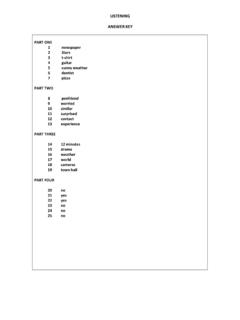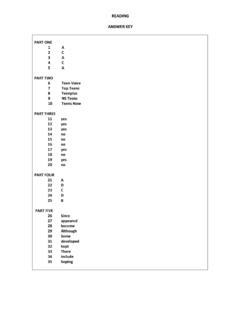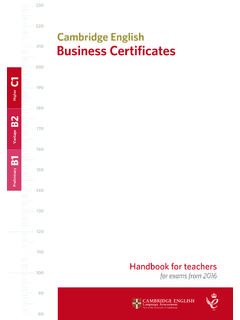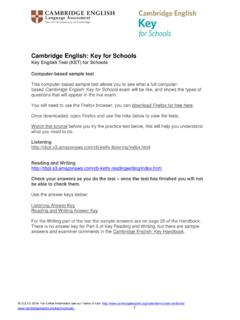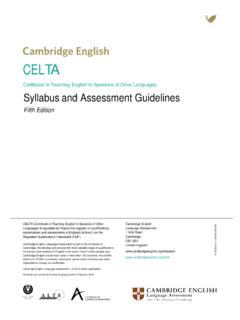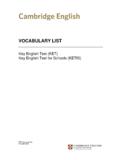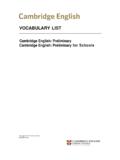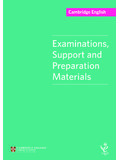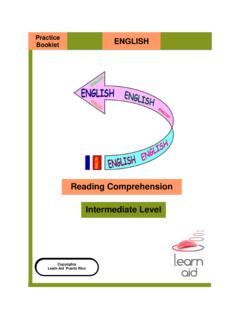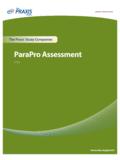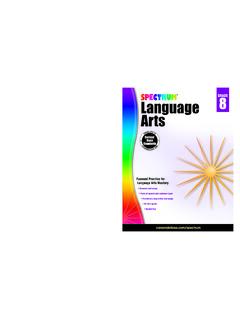Transcription of A2 Key for Schools Reading Part 3 - Cambridge English
1 1 A2 Key for Schools Reading part 3 Description This lesson plan has been created to help students prepare for A2 Key for Schools Reading part 3. This lesson plan can be delivered face to face or online. The online options column gives teachers ideas about how the stages could be adapted for teaching online. In this lesson learners are given opportunities to discuss their school life. Learners explore, apply, and then reflect upon a series of strategies for successful completion of A2 Key for Schools Reading part 3. These involve skim Reading , intensive Reading identifying the main points, and some details, in a text.
2 Time required: 60 minutes Materials required: A2 Key for Schools Reading part 3 sample task Key exam information handout Exam strategies handout Prepared presentation/PowerPoint slides Aims: To discuss the topic of school To develop the skill of skimming a Reading text for important information To develop learners ability to identify the key points in a text To develop strategies for the A2 Key for Schools Reading part 3. Procedure Lesson Stages Online options Welcome students. Ask learners to say hello to confirm they can see and hear you. Lead in Show learners a selection of images that represent different aspects of school life.
3 Access and download high-resolution royalty-free images from or similar internet image banks. Reveal the following questions one at a time. After giving individual thinking time, prompt learners to share and justify their answers. Note that there are no correct answers to this activity. 1. What do they all have in common? ( school ) 2. Which could be the odd one out? Why? 3. What do you think is missing from the selection of pictures? (See example images from in materials below). Learners in smaller classes may share ideas using their microphone and benefit from the speaking practice. Allowing learners in larger classes to share ideas through the platform s chat function enables everyone to participate.
4 Explain that learners will read a text about school , written by Anna Gray. If possible, enable learners to 2 Give learners time to consider who Anna might be, elicit some ideas: A pupil, a teacher, a headteacher, a journalist, a historian. Tell learners you will show them the start of the text so they can check their answers, but only for 10 seconds (then reveal the following). Starting at a new school By Anna Gray, age 11. Tell learners to compare answers, before eliciting ideas in front of the whole class. (She is a school pupil, writing about starting at a new school ). Put learners in pairs/groups and challenge them to list all the different things Anna may have written about (for example friends, timetables, lunchtime).
5 Manage feedback, asking each group the number of ideas they listed. Get feedback from pairs with the fewest ideas first, then ask others to add any extras. Record these on the board. Some possible answers: Friends, timetables, different subjects, homework, the journey to school , the teachers. Elicit the benefits of considering a topic before Reading or listening about it: It helps you remember what you already know about a topic, which helps you to predict what you may hear or read. This can make it easier to understand the text and motivate you to read it. share ideas in groups through online collaborative tools (for example, by creating googledocs for each group).
6 Otherwise, guide learners to individually share their ideas with the platform s chat function. If your platform allows it, students could annotate the teacher s presentation. Preparing to skim Explain that learners will read the text and answer two questions. They will only have 30 seconds to answer them. Before looking at the questions or the text, present learners with the following statements (without the answers): When skimming, I need to: 1. understand everything? (False) 2. get a general understanding of the text? (True) 3. read every word slowly and carefully? (False) 4. look at the title, the sentences at the start of paragraphs, and let your eyes move over the whole text, looking for words or themes that appear often (True) 5.
7 I skim texts in my first language Allow learners to consider the statements individually before discussing in pairs. Explain the task using your microphone, or your onscreen presentation. Create a poll (for example, ) incorporating statements 1-4. Get students to respond, indicating whether they are true or false. Prompt learners to share examples of when they skim, in the chat. 3 Skim Reading Show students the following questions: Did Anna find everything very familiar, easy and fun? Which of the suggested topics are in the text? Display text for 30 seconds as learners skim. Learners to share their answers and where they were found, in pairs.
8 Teacher to elicit answers prompting learners to indicate where the various topic areas are located. Highlight that in 40 seconds (looking at the title and skim Reading ) learners have a good understanding of: who wrote the text the topic areas covered how the text is organised and where certain information is. Either display the text for a limited time using your platform s screen-share function or share it with them beforehand. Exam knowledge Explain that the text is from A2 Key for Schools Reading part 3. Give learners the Key exam information handout (below). Instruct learners to complete it based on their current knowledge of the exam.
9 Prompt learners to compare answers. Do not confirm correct answers as learners will discover these themselves as they complete the task. They can update the handout later in the lesson. Copy and paste the first statement from Key exam information handout into your platform s chat or share the entire handout via your platform or email. Exam strategies Focus learners on the first question (question 14). Elicit what the question asks about: Her feelings about changing/going to a different school . Instruct learners to identify the paragraph in the text that question 14 refers to (first paragraph).
10 If possible display the text using your platform s whiteboard, asking learners to highlight areas of text that contain key information (if this gets too difficult to manage, then you can ask learners to tell you which areas to highlight). Instead of comparing answers in pairs/groups, ask the questions one-by-one in the chat, giving learners individual thinking time before prompting them to share answers. This allows everyone to actively participate. 4 Focus learners on the first option: A. worried about being with lots of older children and elicit the content words (worried, older children). Highlight these.
